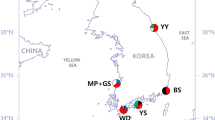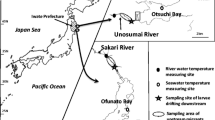Abstract
In recent years, thicklip grey mullet Chelon labrosus has shown increasing expansion of its native habitats in the north-eastern Atlantic into northerly adjacent areas including the North Sea and the brackish Baltic Sea. Despite the regular annual and seasonal occurrence of C. labrosus in the western Baltic during the warm months, nothing is known of the origin or whereabouts of the mullet during the cold season. As different possible migration scenarios can be considered, we performed otolith microchemistry analyses on specimens from the western Baltic Sea to identify the origin of this nonindigenous species. Comparison with North Sea samples revealed common habitat preferences and underlined the highly euryhaline nature of C. labrosus in different recently occupied habitats. Occasional fluctuations of Sr/Ca ratio along the growth axis suggest periodical migration between waters of different salinities but did not reveal distinct migration pathways.




Similar content being viewed by others
References
Nelson JS (2006) Fishes of the world, 4th edn. Wiley, Hoboken
Harrison IJ (2003) Mugilidae. In: Carpenter KE (ed) The living marine resources of the western central Atlantic, FAO species identification guide for fishery purposes, vol 2. FAO, Rome, pp 1071–1085
Chang CW, Iizuka Y, Tzeng WN (2004) Migratory environmental history of the grey mullet Mugil cephalus as revealed by otolith Sr:Ca ratios. Mar Ecol Prog Ser 269:277–288
Hsu CC, Chang CW, Iizuka Y, Tzeng WN (2009) A growth check deposited at estuarine arrival in otoliths of juvenile Flathead Mullet (Mugil cephalus L.). Zool Stud 48:315–324
Wang CH, Hsu CC, Chang CW, You CF, Tzeng WN (2010) The migratory environmental history of freshwater resident Flathead Mullet Mugil cephalus L. in the Tanshui River, Northern Taiwan. Zool Stud 49:504–514
Thomson JM (1966) The grey mullets. Oceanogr Mar Biol Ann Rev 4:301–335
Muus BJ, Nielsen JG (1999) Sea Fish. Scandinavian fishing year book, Hedehusene
Heincke F (1894) Fishes of Helgoland. Wiss Meersunters Abt Helgoland 1:100–120 (in German)
Mohr EW (1928) Teleostei Physoclisti: 5. Atheriniformes. In: Die Tierwelt der Nord- und Ostsee 4. Akademische Verlagsgesellschaft, Leipzig, Germany, pp 36–44 (in German)
Meyer PF (1935) Marine and brackish fishes of Mecklenburg. Arch Ver Freunde Naturgesch Mecklenburg 9:59–98 (in German)
Mohr H (1988) On the biology of the grey mullets and their importance for fisheries at the German coast. Protok Fisch Tech 15:163–175 (in German with English abstract)
Meixner M (1978) Grey mullets presently are not considered as rare vagrants anymore. Inf Fischwirtsch 25:95–96 (in German)
Mohr H (1986) The grey mullet—a new fish species in the Wadden Sea. Seevögel 7:63–65 (in German with English summary)
BLE (2009) Catches and landings from German commercial fisheries. Bundesanstalt für Landwirtschaft und Ernährung. Federal Institute for Agriculture and Food, Ref. 522, Hamburg
Mohr H, Horn W (1977) Trials in catching grey mullets in the Wadden Sea. Inf Fischwirtsch 24:174–176 (in German)
Vorberg R, Bolle L, Jager Z, Neudecker T (2005) Wadden Sea Quality Status Report 2004. Fish Wadden Sea Ecosyst 19:219–236
Commission OSPAR (2000) Quality Status Report 2000, Region II—Greater North Sea. OSPAR Commission, London
Siedler G, Hatje G (1974) Temperature, salinity and density. In: Maagard L, Rheinheimer G (eds) Meereskunde der Ostsee. Springer-Verlag, Berlin, pp 43–60 (in German)
Postma H (1982) Hydrography of the Wadden Sea: movements and properties of water and particulate matter. In: Wolff WJ (ed) Ecology of the Wadden Sea, vol 1. A. A. Balkema, Rotterdam, pp 2/1–2/75
Campana SE (1999) Chemistry and composition of fish otoliths: pathways, mechanisms and applications. Mar Ecol Prog Ser 188:263–297
Elsdon TS, Wells BK, Campana SE, Gillanders BM, Jones CM, Limburg KE, Secor DH, Thorrold SR, Walther BD (2008) Otolith chemistry to describe movements and life-history patterns of fishes: Hypotheses, assumptions, limitations and inferences. Oceanogr Mar Biol Ann Rev 46:297–330
Kimura R, Secor DH, Houde ED, Piccoli PM (2000) Up-estuary dispersal of young-of-the-year bay anchovy Anchoa mitchilli in the Chesapeake Bay: inferences from microprobe analysis of strontium in otoliths. Mar Ecol Prog Ser 208:217–227
Shen KN, Chang CW, Iizuka Y, Tzeng WN (2009) Facultative habitat selection in Pacific tarpon Megalops cyprinoides as revealed by otolith Sr:Ca ratios. Mar Ecol Prog Ser 387:255–263
Tzeng WN, Severin KP, Wickstrom H (1997) Use of otolith microchemistry to investigate the environmental history of European eel Anguilla anguilla. Mar Ecol Prog Ser 149:73–81
Limburg KE (1995) Otolith strontium traces environmental history of subyearling American Shad Alosa sapidissima. Mar Ecol Prog Ser 119:25–35
Miles NG, West RJ, Norman MD (2009) Does otolith chemistry indicate diadromous lifecycles for five Australian riverine fishes? Mar Freshw Res 60:903–911
Hotos GN (2003) A study on the scales and age estimation on the grey golden mullet, Liza aurata (Risso, 1810), in the lagoon of Messolonghi (W. Greece). J Appl Ichthyol 19:220–228
Pearce NJG, Perkins WT, Westgate JA, Gorton MP, Jackson SE, Neal CL, Chenery SP (1997) A compilation of new and published major and trace element data for NIST SRM 610 and NIST SRM 612 glass reference materials. Geostand Newslett 21:115–144
Marohn L, Prigge E, Zumholz K, Klügel A, Anders H, Hanel R (2009) Dietary effects on multi-element composition of European eel (Anguilla anguilla) otoliths. Mar Biol 156:927–933
Mosegaard H, Svedang H, Taberman K (1988) Uncoupling between somatic and otolith growth in arctic char (Salvelinus alpinus) as an effect of differences in temperature response. Can J Fish Aquat Sci 45:1514–1524
Hickling CF (1970) A contribution to the natural history of the English grey mullets (Pisces, Mugilidae). J Mar Biol Assoc UK 65:609–633
Ehlers J et al (1994) Geo-morphology and hydrography of the Wadden Sea. In: Lozán JL (ed) Warnsignale aus dem Wattenmeer. Blackwell, Berlin, pp 1–10 (in German)
Le Dantec J (1955) Quelques observations sur la biologie des muges des reservoirs de Certes (Audenge). Rev Trav Inst Pech Marit 19:93–112
Elsdon TS, Gillanders BM (2005) Strontium incorporation into calcified structures: separating the effects of ambient water concentration and exposure time. Mar Ecol Prog Ser 285:233–243
Ben-Tuvia A (1996) Mugilidae. In: Whitehead PJP, Bauchot ML, Hureau JC, Nielsen J, Tortonese E (eds) Fishes of the North-eastern Atlantic and the Mediterranean, vol 3. UNESCO, Paris, pp 1197–1204
Sadovy Y, Severin KP (1994) Elemental patterns in Red Hind (Epinephelus guttatus) otoliths from Bermuda and Puerto-Rico reflect growth-rate, not temperature. Can J Fish Aquat Sci 51:133–141
Secor DH, Henderson-Arzapalo A, Piccoli PM (1995) Can otolith microchemistry chart patterns of migration and habitat utilization in anadromous fishes. J Exp Mar Biol Ecol 192:15–33
Elsdon TS, Gillanders BM (2005) Alternative life-history patterns of estuarine fish: barium in otoliths elucidates freshwater residency. Can J Fish Aquat Sci 62:1143–1152
Milton DA, Chenery SR (2003) Movement patterns of the tropical shad hilsa (Tenualosa ilisha) inferred from transects of Sr-87/Sr-86 isotope ratios in their otoliths. Can J Fish Aquat Sci 60:1376–1385
Gehrke PC, Gilligan DM, Barwick M (2001) Fish communities and migration in the Shoalhaven River—before construction of a fishway. NSW Fish Fin Rep Ser 26, New South Wales Fisheries, Port Stephens
Butler GA, Mackay B, Rowland SJ, Pease BC (2009) Retention of intra-peritoneal transmitters and post-operative recovery of four Australian native fish species. Mar Freshw Res 60:361–370
Arechavala-Lopez A, Uglem I, Sanchez-Jerez P, Fernandez-Jover D, Bayle-Sempere JT, Nilsen R (2010) Movements of grey mullet Liza aurata and Chelon labrosus associated with coastal fish farms in the western Mediterranean Sea. Aquacult Environ Interact 1:127–136
Heras S, Roldán MI, Castro MG (2009) Molecular phylogeny of Mugilidae fishes revised. Rev Fish Biol Fish 19:217–231
Antonov JI, Seidov D, Boyer TP, Locarnini RA, Mishonov AV, Garcia HE, Baranova OK, Zweng MM, Johnson DR (2010) World Ocean Atlas 2009. Salinity. NOAA Atlas NEDSIS 69, vol 2. US Government Printing Office, Washington
Acknowledgments
We would like to thank an anonymous fly fisher who donated his catch to us and also the fishermen A. Kadell, H.W. Kruse, and H. Meier for the samples from the Baltic and J. Orth for the North Sea individuals. Thanks also go to C. Clemmesen (IFM-GEOMAR) for providing the authors with weekly hydrographic time series data. E. Prigge and A. Frommel assisted during dissections and otolith preparations. A. Klügel and H. Anders from Bremen University are acknowledged for the optimal logistics and excellent conditions found during use of the LA-ICPMS, and we thank M. Thöner (IFM-GEOMAR) for his kind support during the use of the EMPA. Additional thanks go to two anonymous reviewers for their valuable suggestions to improve this manuscript.
Author information
Authors and Affiliations
Corresponding author
Rights and permissions
About this article
Cite this article
Schaber, M., Marohn, L., Petereit, C. et al. Newcomers in the Baltic Sea: an attempt to trace the origins and whereabouts of thicklip grey mullet Chelon labrosus . Fish Sci 77, 757–764 (2011). https://doi.org/10.1007/s12562-011-0384-1
Received:
Accepted:
Published:
Issue Date:
DOI: https://doi.org/10.1007/s12562-011-0384-1




